Charles E W Bean, Diaries, AWM38 3DRL 606/264/1 - 1914 - 1938 - Part 5
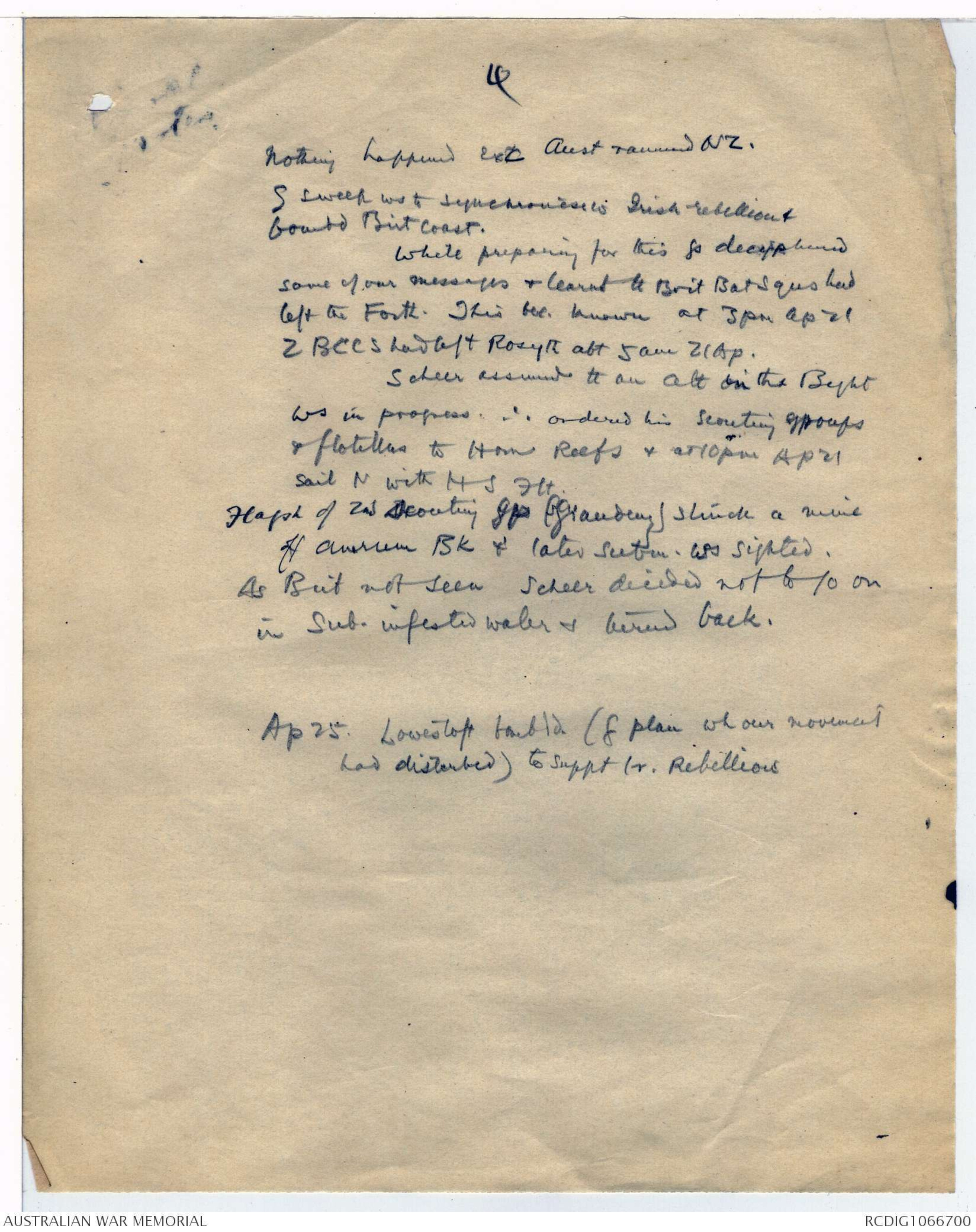
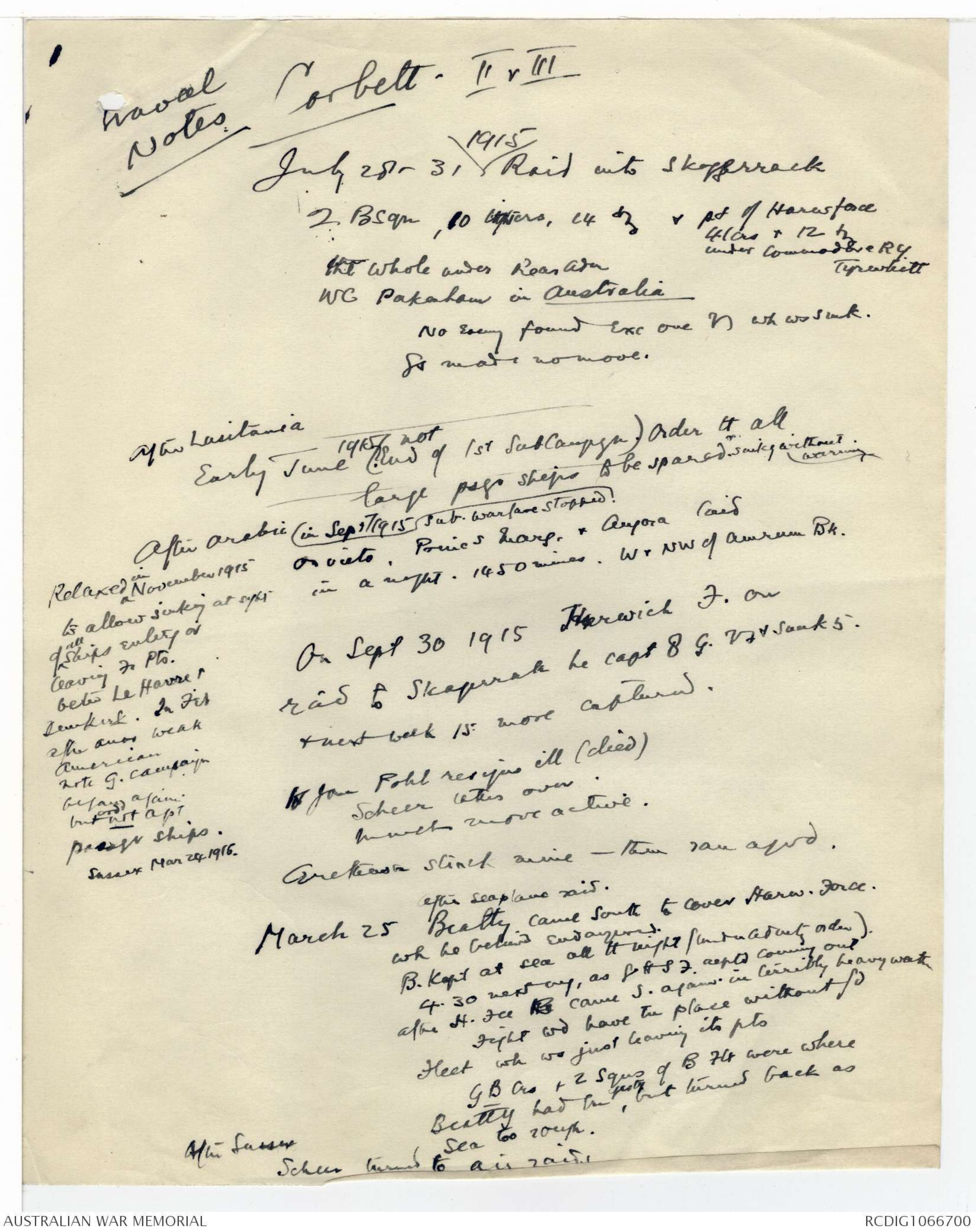
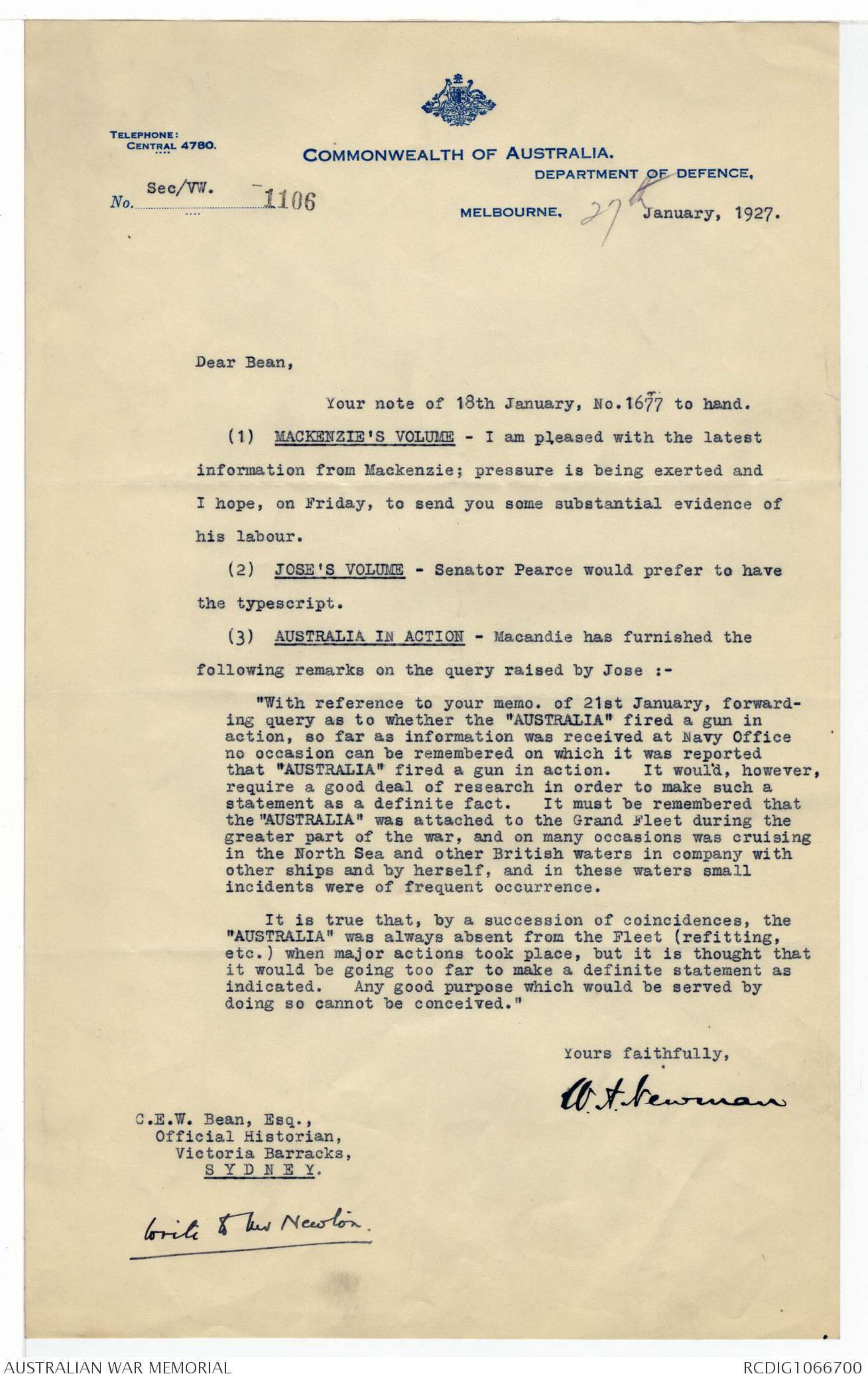

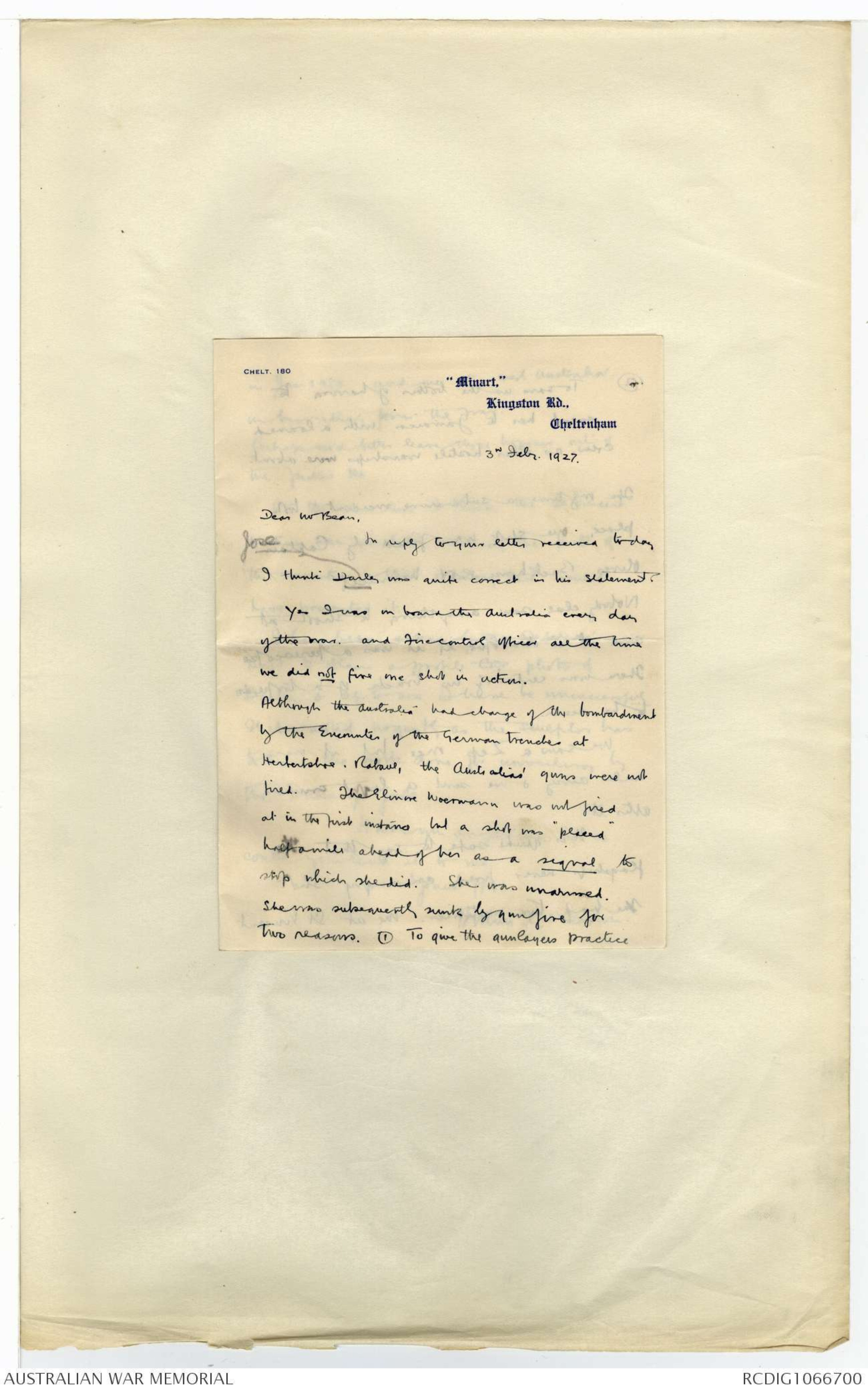
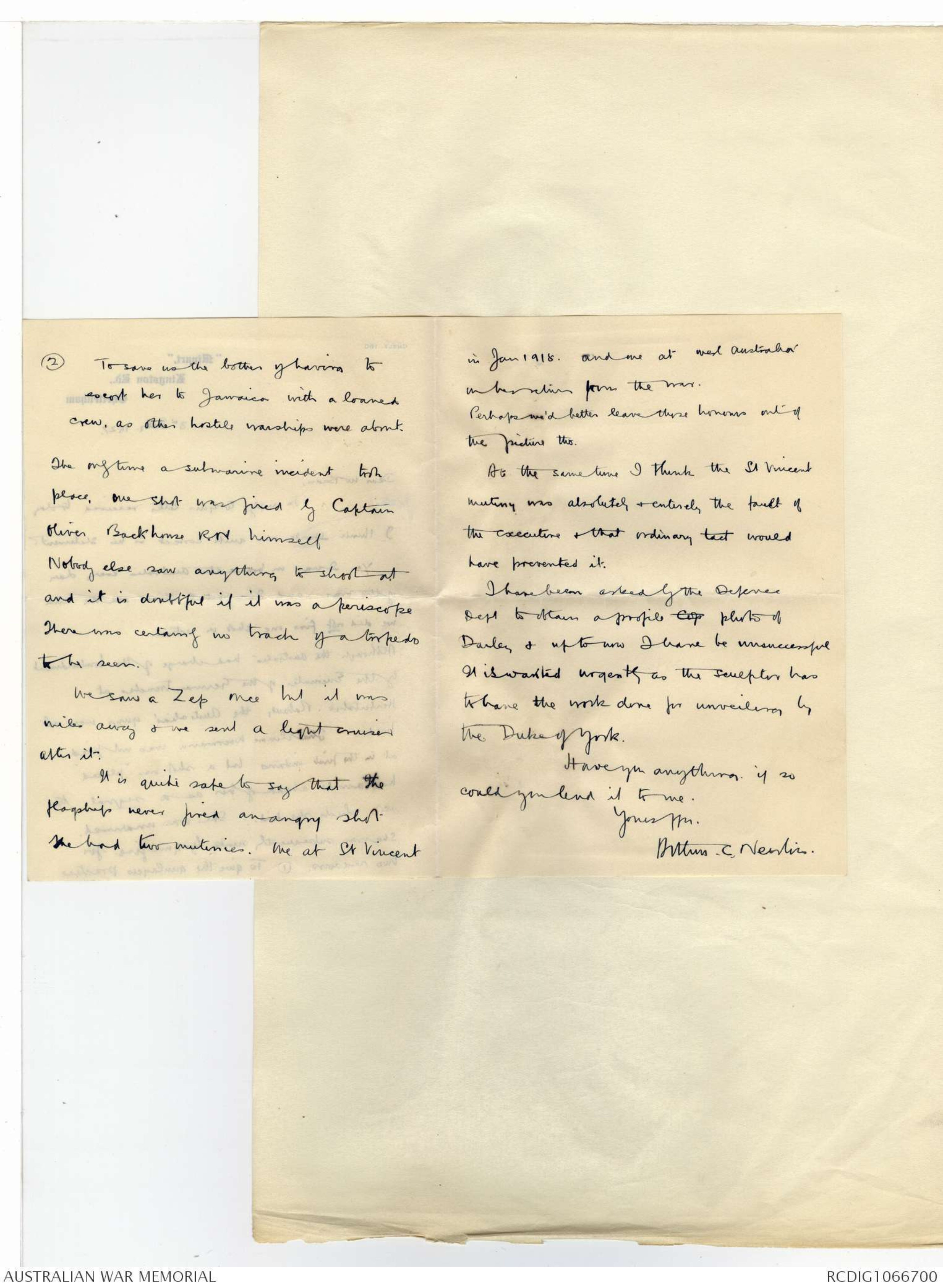

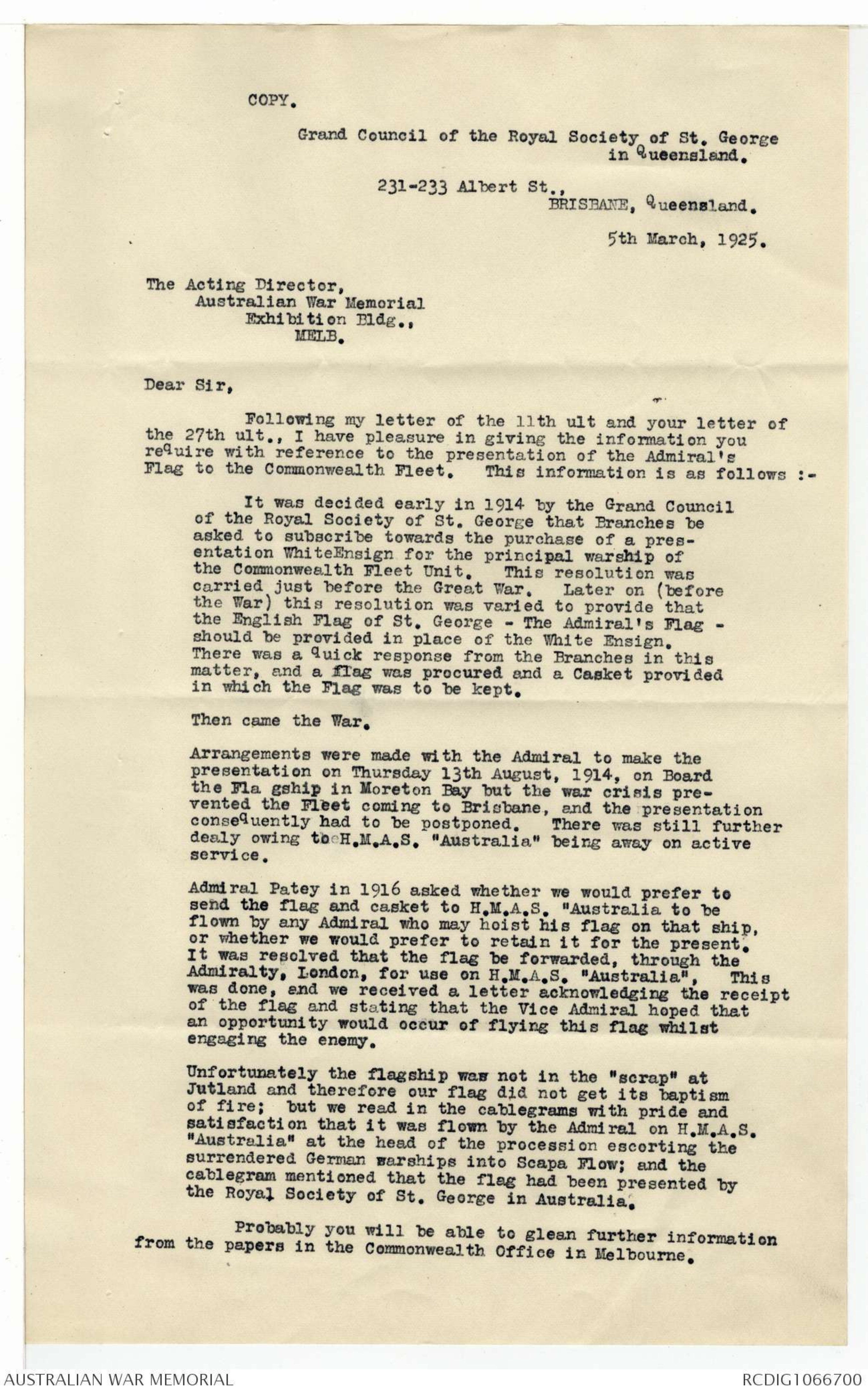
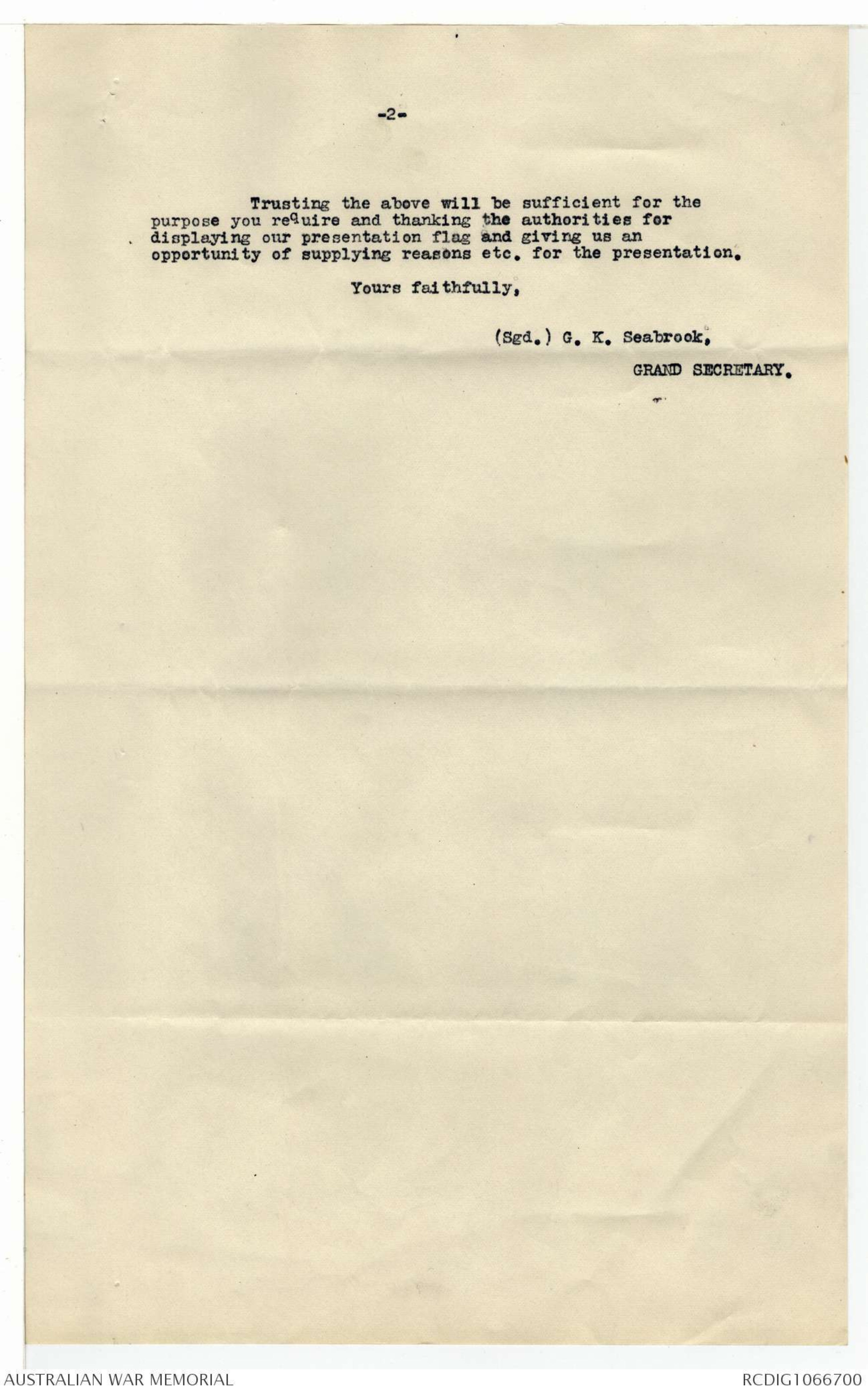
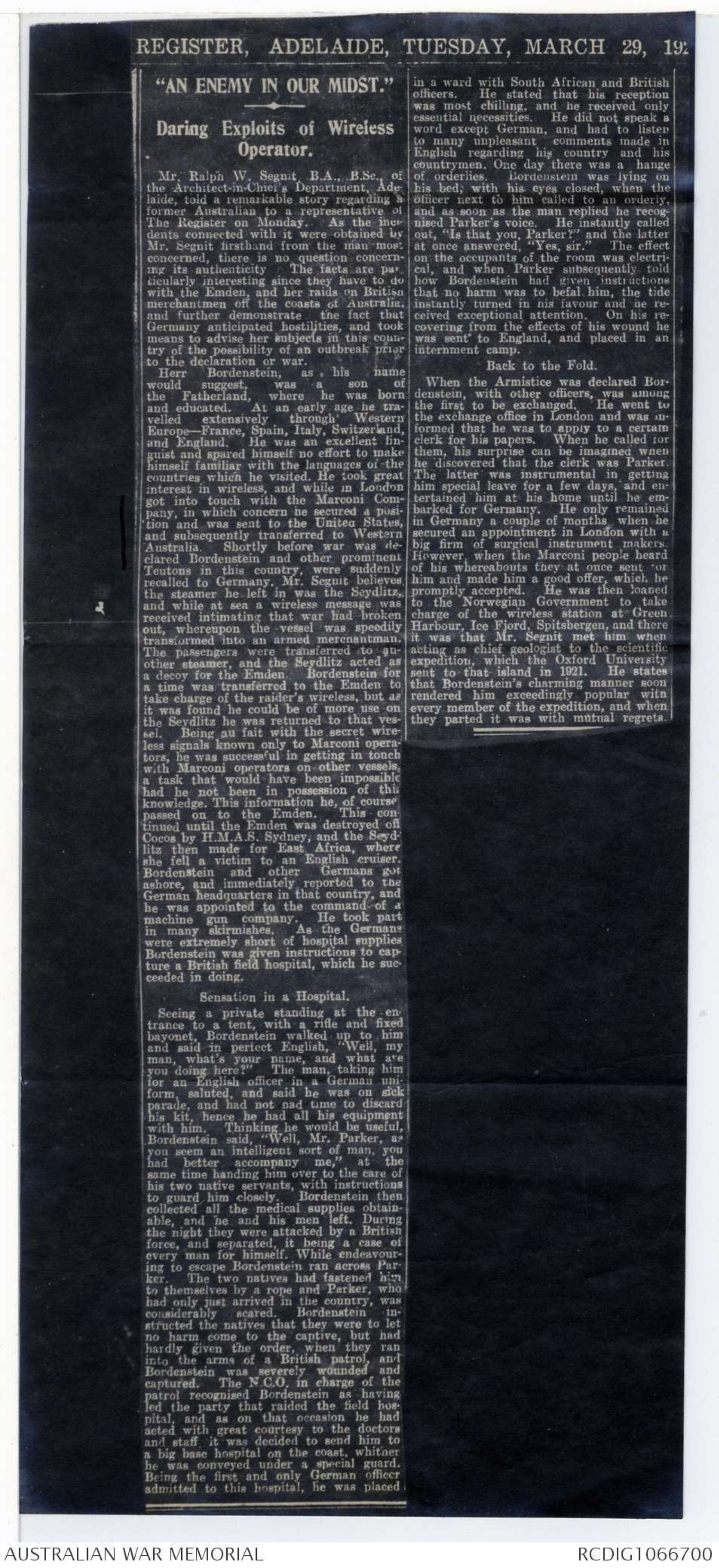
4
Nothing happened exc Aust [[?]] NZ.
G sweep ws to synchronise Irish rebellion &
bombd Brit coast.
While preparing for this Gs decyphered
some of our messages & learnt tt Brit Bat Sqns had
left the Forth. This bec. known at 3 pm Apr 21
2 BCCS had left Rosyth abt 5 am 21 Ap.
Scheer assumed tt an att on the Bight
ws in progress. therefore ordered his scouting groups
& flotillas to Horn Reefs & at 10 pm Ap 21
sail N with H S Flt.
Flagsh of 2nd Scouting Gp (Graudenz) struck a mine
off Amrum Bk & later subm. ws sighted.
As Brit not seen Scheer decided not to go on
in sub. infested water & turned back.
Ap 25. Lowestoft bombld (G plan wh our movement
had disturbed) to suppt Ir. Rebellion
Naval Notes. Corbett - II & III
July 28 & 31 ^ 1915 Raid into Skaggerack
2 B Sqn, 10 lighters, 14 destroyers & prt of Harwforce
41 crs and 12 destroyers under Commodore R Y Tyrwhitt
the whole under Rear Adm
W C Pakenham in Australia
No enemy found exc one trawler wh ws sunk.
Gs made no move.
After Lusitania
Early June 1915 (not ?End of 1st Sub Campgn.) Order tt all
large psgr ships to be spared sinkg without warning.
After Arabic sub. warfare stopped in Sept 7 1915.
Orvieto. Princs Marg. & Angora laid
in a night. 1450 mines. W & NW of Amrum Bk.
On Sept 30 1915 Harwich F. on
raid to Skaggerak he capt 8 G. trawlers & sank 5.
& next week 15 more captured.xx Jan Pohl resigns ill (died)
Scheer takes over.
Much more active.
Arethusa struck mine - then ran agrd.
March 25 after seaplane raid.
Beatty came south to cover Harw. Force.
which he believed endangered.
B. kept at sea all tt night (under Admty order).
4.30 next mg, as G H S F. reptd coming out
after H. Fce He came S. again in terribly heavy weather
Fight wd have tn place without Gd
Fleet wh ws just leaving its pts
G B Crs & 2 sqns of B Flt were where
Beatty had bn yesty, but turned back as
sea too rough.
After Sussex Scheer turned to air raids.
[*Relaxed ^ in November 1915
to allow sinking at sight
of ^ all ships enterg or
leaving Fr Pts.
betw Le Havre &
Dunkirk. In Feb
after anor weak
American
note G. campaign
began again.
but ord not agst
passgr ships.
Sussex Mar 24 1916.*]
TELEPHONE
CENTRAL 4780.
COMMONWEALTH OF AUSTRALIA.
DEPARTMENT OF DEFENCE,
No. Sec/VW. 1106
MELBOURNE. 27th January, 1927.
Dear Bean,
Your note of 18th January, No.1677 to hand.
(1) MACKENZIE'S VOLUME - I am pleased with the latest
information from Mackenzie; pressure is being exerted and
I hope, on Friday, to send you some substantial evidence of
his labour.
(2) JOSE'S VOLUME - Senator Pearce would prefer to have
the typescript.
(3) AUSTRALIA IN ACTION - Macandie has furnished the
following remarks on the query raised by Jose:-
"With reference to your memo. of 21st January, forwarding
query as to whether the "AUSTRALIA" fired a gun in
action, so far as information was received at Navy Office
no occasion can be remembered on which it was reported
that "AUSTRALIA" fired a gun in action. It would, however,
require a good deal of research in order to make such a
statement as a definite fact. It must be remembered that
the "AUSTRALIA" was attached to the Grand fleet during the
greater part of the war, and on many occasions was cruising
in the North sea and other British waters in company with
other ships and by herself, and in these waters small
incidents were of frequent occurrence.
It is true that, by a succession of coincidences, the
"AUSTRALIA" was always absent from the Fleet (refitting,
etc.) when major actions took place, but it is thought that
it would be going too far to make a definite statement as
indicated. Any good purpose which would be served by
doing so cannot be conceived."
Yours faithfully,
W.A. Newman
C.E.W. Bean, Esq.,
Official Historian,
Victoria Barracks,
S Y D N E Y.
Write to Mr Newton.
xxxxxxxxxxx
F.4151
1711.
1 February 1927.
A.C. Newton, Esq.,
"Minart".
Kingston Road,
Cheltenham, Vic.
Dear Mr. Newton,
You were so kind as to give me recently certain particulars
concerning Commander Darley, of which I have been able to
make use in auditing the official history of the R.A.N. in the
Great War. I should be grateful if you would assist me in
connection with another point.
In dealing with the services of the Australia, on which
he places a high value, the author has pointed a remarkable
contrast by saying that it was a strange fact that, while the
Pioneer, which was almost an obsolete ship, probably fired
more shells at the enemy than any other vessel of the R.A.N.,
during the war, the Australia, which was the most modern and
powerful, never fired a shot in action. I do not know
whether you were with the Australia during the whole of the
war, but, if so, would you kindly tellmme whether this statement
is correct? A shot fired to stop or sink the Eleonore
Weermann would, I suppose, not count as a shot fired in action,
nor would one fired at an invisible or non-existent submarine;
but a shot fired at a submarine after it had been sighted, or
at a Zeppelin or aeroplane, would count as one fired in action.
Yours sincerely,
C. E. W. BEAN
CHELT. 180
"Minart,"
Kingston Rd.,
Cheltenham
3rd Febr. 1927.
Dear Mr. Bean,
In reply to your letter received today
I think that Jose Darley was quite correct in his statement.
Yes I was on board the Australia every day
of the war, and Fire Control Officer all the time
we did not fire one shot in action.
Although the Australia had charge of the bombardment
by the Encounter of the German trenches at
Herbertshoe, Rabaul, the Australias' guns were not
fired. The Elinore Woermann was not fired
at in the first instance but a shot was "placed"
half a mile ahead of her as a signal to
stop which she did. She was unarmed.
She was subsequently sunk by gunfire for
two reasons. (1) To give the gunlayers practice
(2) To save us the bother of having to
escort her to Jamaica with a loaned
crew, as other hostile warships were about.
The only time a submarine incident took
place, one shot was fired by Captain
Oliver Backhouse R.N. himself
Nobody else saw anything to shoot at
and it is doubtful if it was a periscope
There was certainly no track of a torpedo
to be seen.
We saw a Zep once but it was
miles away & we sent a light cruiser
after it.
It is quite safe to say that the
flagship never fired an angry shot
She had two mutinies. One at St Vincent
in Jan 1918. and one at West Australia
in her return from the war.
Perhaps we'd better leave those honours out of
the picture tho.
At the same time I think the St Vincent
mutiny was absolutely & entirely the fault of
the executive & that ordinary tact would
have prevented it.
I have been asked by the Defence
Dept to obtain a profile cop photo of
Darley & up to now I have be unsuccessful
It is wanted urgently as the sculptor has
to have the work done for unveiling by
the Duke of York.
Have you anything. if so
could you lend it to me.
Yours ffy.
Arthur C. Newton.
TELEPHONE Nos.
F 2597.
F 2598.
COMMONWEALTH OF AUSTRALIA.
HOME AND TERRITORIES DEPARTMENT.
TELEGRAPHIC ADDRESS
"AUSWARMUSE."
COMMUNICATIONS TO BE ADDRESSED TO
"THE DIRECTOR."
IN REPLY PLEASE QUOTE
NO. 7/4/153.
AUSTRALIAN WAR MEMORIAL.
EXHIBITION BUILDINGS, MELBOURNE.
7th February, 1927.
Dear Mr. Bazley,
If, in referring to the presence of the
"Australia" at the surrender of the German Fleet,
you were to mention that on this occasion she flew
a flag presented to her by the Royal Society of St.
George in Queensland, you would, I feel sure, fill
with pride the hearts of many loyal Englishmen in
Queensland. Whether or not such a "mention" is
justified is of course quite another matter.
The flag was presented to the Australian
War Memorial some time ago. I have recently been
preparing a revised description and it was this that
led me to make the above suggestion. As it may
possibly be of interest to you I am sending herewith
a copy of a letter received from the Grand Secretary
in which the history of the flag is given.
Yours sincerely,
JL Treloar
Mr. A. W. Bazley,
C/o Official Historian,
Victoria Barracks,
SYDNEY.
COPY.
Grand Council of the Royal Society of St. George
in Queensland.
231-233 Albert St.,
BRISBANE, Queensland.
5th March, 1925.
The Acting Director,
Australian War Memorial
Exhibition Bldg.,
MELB.
Dear Sir,
Following my letter of the 11th ult and your letter of
the 27th ult., I have pleasure in giving the information you
require with reference to the presentation of the Admiral's
Flag to the Commonwealth Fleet. This information is as follows:-
It was decided early in 1914 by the Grand Council
of the Royal Society of St. George that Branches be
asked to subscribe towards the purchase of a presentation
WhiteEnsign for the principal warship of
the Commonwealth Fleet Unit. This resolution was
carried just before the Great War. Later on (before
the War) this resolution was varied to provide that
the English Flag of St. George - The Admiral's Flag -
should be provided in place of the White Ensign.
There was a quick response from the Branches in this
matter, and a flag was procured and a Casket provided
in which the Flag was to be kept.
Then came the War.
Arrangements were made with the Admiral to make the
presentation on Thursday 13th August, 1914, on Board
the Fla gship in Moreton Bay but the war crisis prevented
the Fleet coming to Brisbane, and the presentation
consequently had to be postponed. There was still further
dealy owing to the H.M.A.S. "Australia" being away on active
service.
Admiral Patey in 1916 asked whether we would prefer to
send the flag and casket to H.M.A.S. "Australia to be
flown by any Admiral who may hoist his flag on that ship,
or whether we would prefer to retain it for the present.
It was resolved that the flag be forwarded, through the
Admiralty, London, for use on H.M.A.S. "Australia", This
was done, and we received a letter acknowledging the receipt
of the flag and stating that the Vice Admiral hoped that
an opportunity would occur of flying this flag whilst
engaging the enemy.
Unfortunately the flagship was not in the "scrap" at
Jutland and therefore our flag did not get its baptism
of fire; but we read in the cablegrams with pride and
satisfaction that it was flown by the Admiral on H.M.A.S.
"Australia" at the head of the procession escorting the
surrendered German warships into Scapa Flow; and the
cablegram mentioned that the flag had been presented by
the Royal Society of St. George in Australia.
Probably you will be able to glean further information
from the papers in the Commonwealth Office in Melbourne.
-2-
Trusting the above will be sufficient for the
purpose you require and thanking the authorities for
displaying our presentation flag and giving us an
opportunity of supplying reasons etc. for the presentation.
Yours faithfully,
(Sgd.) G.K. Seabrook,
GRAND SECRETARY.
REGISTER, ADELAIDE, TUESDAY, MARCH 29, 192
"AN ENEMY IN OUR MIDST."
Daring Exploits of Wireless
Operator.
Mr. Ralph W. Segnit, B.A., B.Sc., of
the Architect-in-Chief's Department, Adelaide,
told a remarkable story regarding a
former Australian to a representative of
The Register on Monday. As the incidents
connected with it were obtained by
Mr. Segnit firsthand from the man most
concerned, there is no question concerning
its authenticity. The facts are particularly
interesting since they have to do
with the Emden, and her raids on British
merchantmen off the coasts of Australia,
and further demonstrate the fact that
Germany anticipated hostilities, and took
means to advise her subjects in this country
of the possibility of an outbreak prior
to the declaration of war.
Herr Bordenstein, as his name
would suggest, was a son of
the Fatherland, where he was born
and educated. At an early age he travelled
extensively through Western
Europe - France, Spain, Italy, Switzerland,
and England. He was an excellent linguist
and spared himself no effort to make
himself familiar with the languages of the
countries which he visited. He took great
interest in wireless, and while in London
got into touch with the Marconi Company,
in which concern he secured a position
and was sent to the United States,
and subsequently transferred to Western
Australia. Shortly before war was declared
Bordenstein and other prominent
Teutons in this country, were suddenly
recalled to Germany. Mr. Segnit believes
the steamer he left in was the Seydlitz,
and while at sea a wireless message was
received intimating that was had broken
out, whereupon the vessel was speedily
transformed into an armed merchantman.
The passengers were transferred to another
steamer, and the Seydlitz acted as
a decoy for the Emden. Bordenstein for
a time was transferred to the Emden to
take charge of the raider's wireless, but as
it was found he could be of more use on
the Seydlitz he was returned to that vessel.
Being au fait with the secret wireless
signals known only to Marconi operators,
he was successful in getting in touch
with Marconi operators on other vessels,
a task that would have been impossible
had he not been in possession of this
knowledge. This information he, of course,
passed on to the Emden. This continued
until the Emden was destroyed off
Cocos by H.M.A.S. Sydney, and the Seydlitz
then made for East Africa, where
she fell a victim to an English cruiser.
Bordenstein and other Germans got
ashore, and immediately reported to the
German headquarters in that country, and
he was appointed to the command of a
machine gun company. He took part
in many skirmishes. As the Germans
were extremely short of hospital supplies
Bordenstein was given instructions to capture
a British field hospital, which he succeeded
in doing.
Sensation in a Hospital.
Seeing a private standing at the entrance
to a tent, with a rifle and fixed
bayonet, Bordenstein walked up to him
and said in perfect English, "Well, my
man, what's your name, and what are
you doing here?" The man, taking him
for an English officer in a German uniform,
saluted, and said he was on sick
parade, and had not had time to discard
his kit, hence he had all his equipment
with him. Thinking he would be useful,
Bordenstein said, "Well, Mr. Parker, as
you seem to be an intelligent sort of man, you
had better accompany me," at the
same time handing him over to the care of
his two native servants, with instructions
to guard him closely. Bordenstein then
collected all the medical supplies obtainable,
and he and his men left. During
the night they were attacked by a British
force, and separated, it being a case of
every man for himself. While endeavouring
to escape Bordenstein ran across Parker.
The two natives had fastened him
to themselves by a rope and Parker, who
had only just arrived in the country, was
considerably scared. Bordenstein instructed
the natives that htye were to let
no harm come to their captive, but had
hardly given the order, when they ran
into the arms of a British patrol, and
Bordenstein was severely wounded and
captured. The N.C.O. in charge of the
patrol recognised Bordenstein as having
led the party that raided the field hospital,
and as on that occasion he had
acted with great courtesy to the doctors
and staff, it was decided to sen him to
a big base hospital on the coast, whither
he was conveyed under a special guard.
Being the first and only German officer
admitted to this hospital, he was placed
in a ward with South African and British
officers. He stated that his reception
was most chilling, and he received only
essential necessities. He did not speak a
word except German, and had to listen
to many unpleasant comments made in
English regarding his country and his
countrymen. One day there was a hange
of orderlies. Bordenstein was lying on
his bed, with his eyes closed, when the
officer next to him called to an orderly,
and as soon as the man replied he recognised
Parker's voice. He instantly called
out. "Is that you, Parker?" and the latter
at once answered, "Yes, sir." The effect
on the occupants of the room was electrical,
and when Parker subsequently told
how Bordenstein had given instructions
that no harm was to befal him, the tide
instantly turned in his favour and he received
exceptional attention. On his recovering
from the effects of his wound he
was sent to England, and placed in an
internment camp.
Back to the Fold.
When the Armistice was declared Bordenstein,
with other officers, was among
the first to be exchanged. He went to
the exchange office in London and was informed
that he was to apply to a certain
clerk for his papers. When he called for
them, his surprise can be imagined when
he discovered that the clerk was Parker.
The latter was instrumental in getting
him special leave for a few days, and entertained
him at his home until he embarked
for Germany. He only remained
in Germany a couple of months when he
secured an appointment in London with a
big firm of surgical instrument makers.
However, when the Marconi people heard
of his whereabouts they at once sent for
him and made him a good offer, which he
promptly accepted. He was then loaned
to the Norwegian government to take
charge of the wireless station at Green
harbour, Ice Fjord, Spitsbergen, and there
it was that Mr. Segnit met him when
acting as chief geologist to the scientific
expedition, which the Oxford University
sent to that island in 1921. He states
that Bordenstein's charming manner soon
rendered him exceedingly popular with
every member of the expedition, and when
they parted it was with mutual regrets.
 Sam scott
Sam scottThis transcription item is now locked to you for editing. To release the lock either Save your changes or Cancel.
This lock will be automatically released after 60 minutes of inactivity.